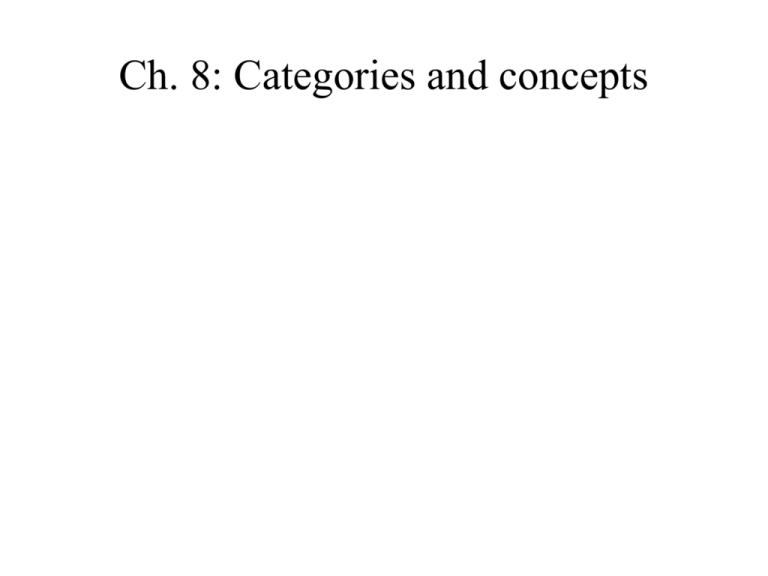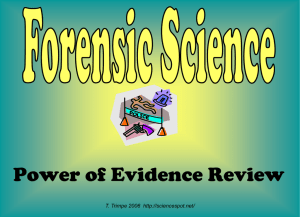L12b categories and concepts 1
advertisement

Ch. 8: Categories and concepts Concept and Knowledge • Topic: – How do we store and manipulate a concept in the brain? Concepts, beliefs and behavior Concept/belief and action • • • • • • • • • Mother Teresa Timothy McVeigh (Oklahoma bomber) Ted Kaczynski (the unabomber) Osama bin Laden Mahatma Gandhi Nelson Mandela George Washington 74 men and women died in Waco, TX Bill Clinton Psychiatric disorders • Anxiety disorder – Is created by an lingering belief on something threatening happens • Maniac depression – Disbelief on one’s ability, fate, etc. Political language: • Compassionate conservative • support the rich but also, supposedly, generous to the poor. • Limousine liberal • extremely rich but appreciate liberal ideas. • War president • A president who deals with war. • Death tax • Inheritance tax • Pro-life • a political position against abortion • Pro-choice • a political position that supports abortion • Insurance premium • Insurance fee • Tax cuts • cutting taxes of one group and raising taxes for others Stereotype • Ethnic conflicts Concept and memory? • Are they two different things? What is the structure of “concept”? This is the today’s topic. Demonstration: • Tell me what you see as accurately as possible. Why do you say “hammer”? • Why not “hand tool”? • Or why not the $15 hammer I bought in Wal Mart last Wednesday? • Why not “animal”? • Or why not “vegetable”? What is “concept”? • I don’t know – But maybe concept we have is related to the way we categorize things Concept --> categories • In order to study “concept”, I’ll talk about “categories” . There are trillions of categories. • Animals, dogs, cats, birds, mammals, furniture, desks, chairs, tables, books, magazines….. • Trees, grass, weed, stones, rocks, sand, mountains, rivers,….. • Games, sports, hobbies, … • school, banks, shops, restaurants, supermarkets, – Nazi!! Fascists!! Terrorists, racists, sexists, pacifists, philanthropists, sophists, aristocrats, workers, bankers, lawyers, accountants, teachers, students, disciples, masters, gurus, beggars, bigots, – Party animals, beasts!!, dogs!!, – CEO, CFO, CIO, UFO, evp, vip, – IC (Indian Chief) Ad hoc categories – People I adore, People I admire, People I hang around, People I need, People I avoid. – Things I love, Things I enjoy, Places I love, Food I hate, music I like, movies I enjoy – countries I want to visit, restaurants I avoid • Circles, triangles, squares, dots, lines, rectangles, plane, • 1, 2, 3, 4, 100, 120, • A, B, C, D,….. • The format of representing a category When we say “dog,” what’s going on in our mind? • What is the mental representation of “categories”? • How do we distinguish in our mind – a dog from a cat? – a circle from a triangle? • What’s going on? – What is the structure? – What is the neural connections? Which woman looks more attractive/friendly/pleasant/capable? Concepts • What determines “dog” vs. “cat” or “table” vs. “vegetable”, “game” vs. “sport”,….. Classical view • Necessary & sufficient rule – we store definitions. Circle --> an area circumscribed by an equidistant curve. Triangles --> an area circumscribed by three straight lines having three angles……….. A circle of friends, Dupon circle, Columbus Circle, Circle line Bermuda triangles, triangle defense (Chicago Bulls) • Brother, sister, mother, father, uncle, • Some concepts may be organized with specific rules. • But how about other categories? – Game? • Basketball, softball, horse race, chess, a wheel of fortune, survivor, roulette, love affair, computer game, Super Mario? – furniture • desk, table, rug? Bed? Computer? TV? Alternative view Concepts and categories – Pink is basically red. – 99 is almost 100. – Orange is sort of yellow. – Austin is like Rome. – San Antonio is very much like Mexico. – Pita can be bread. Concepts and categories II – Red is basically pink. – 100 is almost 99. – Yellow is almost orange. – Rome is like Austin. – Mexico is very much like San Antonio. – Bread can be pita. Birds: which one looks more like “bird”? Which desk is the best example of “desk”? Which game is the best example of “game”? • • • • • • • • • • • • • • • Baseball Chess Basketball Politics Football Golf One-night love affair Snowboarding Checker Ping-Pong Slot machine Poker Mahjong Horse racing NASCAR racing Fruit vs. Vegetable Banana Apple Melon Grapes Lemon Avocado Orange Grape fruit Kiwi Papaya Mango Lime Tomato Onion Carrot Pepper Potato Jalapeno Cucumber Bitter Melon Spinach Garlic Ginger Broccoli Plantain Lettuce Cabbage Pumpkin Example: • Fruits banana – Sweet, can eat without cooking, lots of vitamin, from tropical countries, soft, ripe quickly, easy to eat, kids love it, tasty, can bring it for hiking • Vegetables carrot – Not sweet, not tasty, require some cooking, lots of vitamin, from anywhere, hard, stay long, kids don’t like it, hard Probabilistic view • The boundaries of categories are fuzzy (probabilistically determined). • Some members are more probable than others. • But we are pretty sure about what “dog” means. • How do we mentally represent categorical knowledge? Organization of categories • Members of categories are organized in relation to some focal members. (prototype) • Focal members play the role of a “reference point.” • The boundaries of categories may be fuzzy, but people know pretty well which items are “good/bad” members of a category. – Penguin vs. robin, chair vs. rug, Measuring “goodness” of category members • Rosch et al. (1975) • Experiments: • Subjects were given a list containing the names of category members. • Subjects rated (using a 1-10 scale) the goodness of membership. – E.g., given “pistol”, subjects rated how good a pistol is as a member of the category “weapons.” • Furniture (chair, lamp, rug, dresser, desk, stove, table, stool, television, fan, bed, television, counter) • Fruit (apple, grapefruit, watermelon, banana, cherries, boysenberry, pear, strawberries, lemon, orange, pineapple, nut) • Vehicle (car, airplane, sled, bus, bicycle, wheelchair, truck, boat, tractor, ambulance, trolley, wagon). • Weapon (pistol, arrow, slingshot, sword, tomahawk, whip, knife, cannon, fist, rifle, club, bow) • Vegetable (peas, celery, mushrooms, corn, turnips, potatoes, carrots, tomatoes, green onions, green beans, artichoke, pumpkin)…. • Other categories, bird, sport, toy, clothing. Results: – Correlations: 0.95 or up (=1 is perfect correlation) – People agree very much which items are good/bad examples of a particular category. – Categories have “good” examples and “bad” examples. – The boundaries of categories are graded, and may be arranged probabilistically with “goodness” of membership. • What determine “goodness”? Or what makes a particular item a good example of a category? Typicality and feature distribution • What makes an item a typical member of a category. • How do we perceive a particular item a typical member of a given category? Family resemblance Rosch & Mervis (1975) • Distribution of attributes (features) – The most typical item in a category has the most features in common with other members of a category, – and the fewest features in common with the member of contrasting categories. • These items are ideal examples and may be referred to as “prototype.” Which woman looks more attractive/friendly/pleasant/capable? Which woman looks more attractive/friendly/pleasant/capable? + = Who is he/she? 12 Morphed images of two different human faces ( Angelina Jolie – Brad Pitt by Na Yung Yu) 1 4 6 9 12 15 19 20 By Na Yung Yu By me Just averaging the two faces Vertical structure of categories • Why “dog” rather than “animal”? • Categories have a vertical structure. • Not all levels of categories are created equal. – One intermediate level of categories, which is called, basic level categories, plays a crucial role in our perceptual and cognitive operations Rosch et al. (1978) • Basic (intermediate) level categories – – – – Most efficient in identification Evokes specific visual representations People use this level exclusively for naming Kids tend to learn these names earlier than other levels of categories Exp. 1 • Speed of classification • Shown a category name (animal -upper level, dog-intermediate level, or German shepherd low level) followed by a picture. • Subjects responded whether the category name matched with the picture (pressing a either yes or no key) Animal Bear Polar bear Results : Basic level items are the easiest to classify Response time (ms) Superordinate Basic level Subordinate TRUE 591 535 659 FALSE 630 578 642 Rosch et. al (1975) Basic level categories and representation • Basic level categories evoke specific visual representations. – Given “furniture”, what kind of representation do you have in your mind? – How about “desk”? • Basic level category names evokes a specific pictorial representation Rosh et al. (1978) • Object matching task and priming • Object matching task – Two pictures were shown on a screen briefly side by side. – Subjects’ task was to indicate whether or not the two pictures depicted identical objects 2 conditions • Primed trials – 2 seconds before the presentation of picture pairs, the category name of one of the pair was presented. • Non primed trials – No names were given prior to the trials. • Dependent measure – Accuracy and response time Procedure (primed condition) Animal / cat / Persian cat Depending on trials, upper (animal), basic (intermediate), or low level (Persian cat) category names appeared. Yes/no • 15 subjects primed with upper level names (animal) • 15 subjects primed with basic level names (dog) • 15 subjects low level names (German shepherd) • All the subjects were also given non-primed trials. animal mammal cat kitten Results: RT for “Same” Priming conditions Superordinate (animal) Basic level name (cat) Subordinate (kitten) Primed 620 554 568 Unprimed 592 601 612 Difference -18 47 44 Interpretation • Given the name of a basic level category, people form a specific pictorial representation. Categories/Concept • Categories have a structure. – Horizontal structure • Distinction between dogs vs. Cats. • Prototype, family resemblance – The most typical item in a category has the most features in common with other members of a category, – and the fewest features in common with the member of contrasting categories. – Vertical structure • (Animal, mammal, dog, German Shepherd) • The mid-level categories that we used for naming are called “basic level” categories. • Basic level categories have cognitive and perceptual significance.







